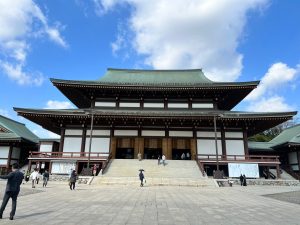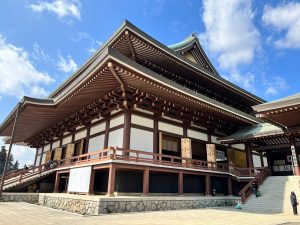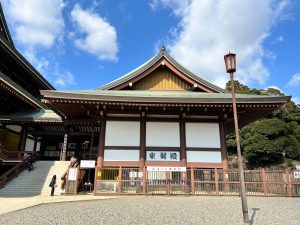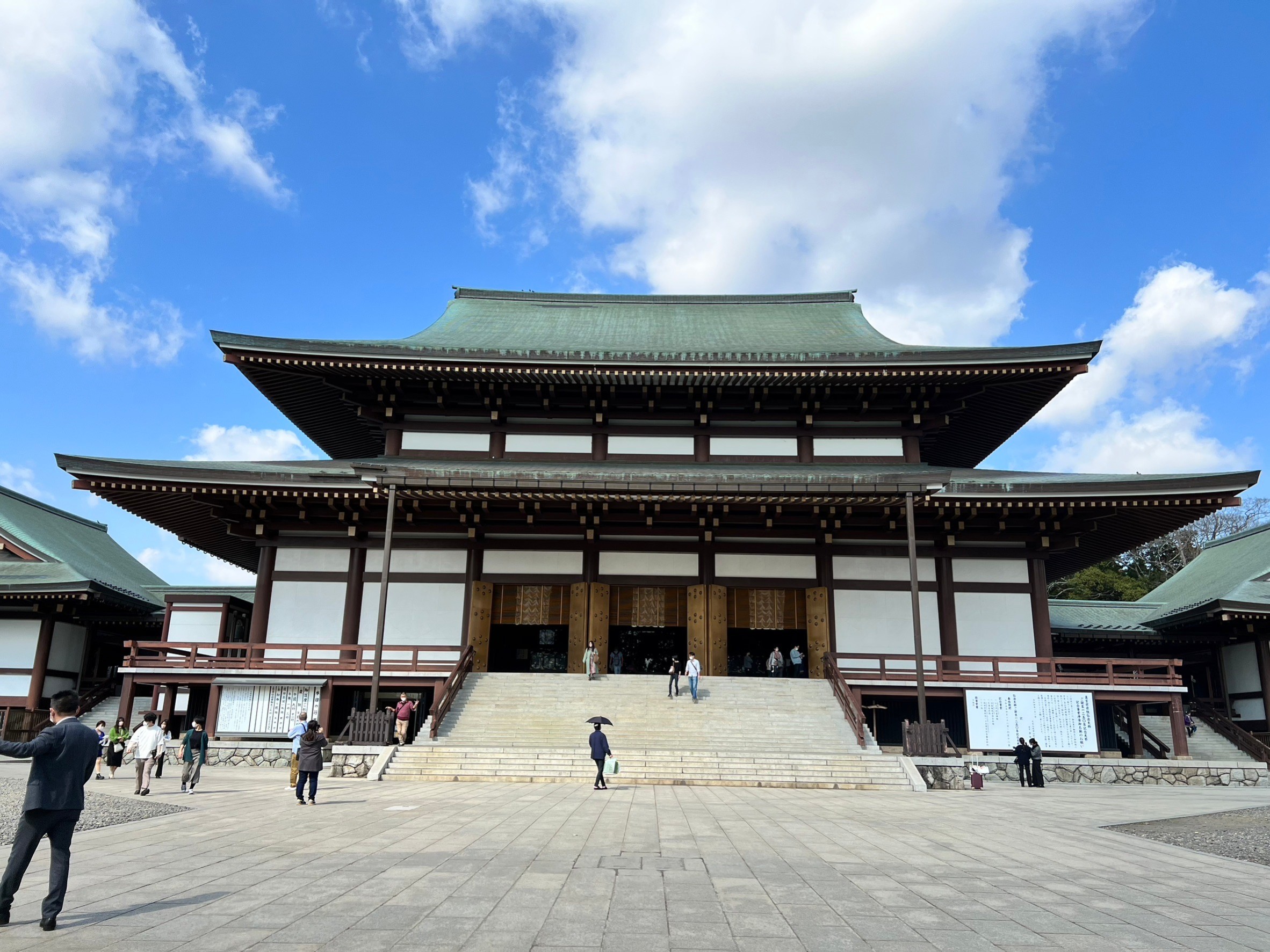
- Overview and History of Naritasan
- The main hall is the central building of Naritasan.
- Main temple building and structure
- Exterior and interior decorations of the main hall, works of art such as sculptures and paintings
- What religious role does the main hall play?
- Religious ceremonies and beliefs in the main hall
- Important temple treasures and Buddha statues kept in the main hall
- The origin and significance of the temple treasures and Buddha statues kept in the main hall
- The Charm of the Main Hall and Summary of Naritasan as a Whole
Overview and History of Naritasan
Naritasan is a Buddhist temple located in Narita City, Chiba Prefecture, and is one of the most famous sacred places in Japan. Officially, it is called Naritasan Shinshoji Temple. Below is an overview and history of Naritasan.
overview:
- Naritasan belongs to the Chisan sect of Shingon Buddhism and is positioned as the head temple.
- In addition to the main hall, the temple has buildings such as a bell tower, a Niomon gate, a three-storied pagoda, and a temple gate.
- Naritasan is dedicated to Kannon Bosatsu, who is known as an object of worship.
history:
- The origin of Naritasan dates back to the Konin era (810-824) of the Heian period.
- According to the legend of the founding of Naritasan, Kobo Daishi (Kukai) saw a dream and felt the latent power as a sacred place, so he decided to build a temple on the mountain.
- After that, in the Kamakura period, Minamoto no Yoritomo protected Mt. Narita and established it as an imperial temple.
- Naritasan has undergone many restorations and reconstructions during the Warring States period and the Edo period, and has developed as a center of worship.
- Especially in the Edo period, many pilgrims visited, and Naritasan worship became known nationwide.
The history of Naritasan is long, and there are various events and changes during that time. Many important cultural assets and Buddha statues are stored in the temple, and it is a place visited by many worshipers and tourists. Naritasan is familiar to many people as a precious place where you can feel the history and religious culture of Japan.
The main hall is the central building of Naritasan.
Naritasan’s central building, the main hall, serves as the temple’s main central location. Below, I will explain what kind of role the main hall plays as the central building of Naritasan.
- Enshrined place of the principal image:
- Kannon Bosatsu, the principal image of Naritasan, is enshrined in the main hall.
- The principal image is revered as an object of faith, and worshipers can visit the main hall to offer prayers to Kannon Bodhisattva.
- Faith base:
- Naritasan is known as a sacred place for Buddhism, and many people visit it with faith.
- The main hall is the central place and serves as the base of faith.
- Worshipers can put their hands together facing the main hall and offer their heartfelt wishes.
- Places of Religious Events and Ceremonies:
- Various religious events and ceremonies are held at Naritasan throughout the year.
- The main hall becomes the stage for these events and ceremonies, where monks and believers gather to participate.
- Ceremonies such as memorial services and sutra chanting in the main hall are held at the center of Naritasan’s religious activities.
- Symbols of history and culture:
- Naritasan is a temple with a long history, and the main hall is a symbol of that history and culture.
- The architecture and decoration of the main hall reflect the characteristics of a particular era and culture.
- Important cultural properties and Buddhist statues are stored within the temple grounds, and the main hall also functions as a place to protect and display these precious heritages.
As described above, Naritasan’s main hall is the center of the temple and plays an important role as an object of worship and as a stage for religious events. It also has a strong presence as a symbol of history and culture.

Main temple building and structure
Naritasan’s main hall is the central building of a Buddhist temple with a profound and beautiful architectural style. Below is a detailed description of the main hall building and structure.
- Appearance of the building:
- The main hall is a traditional Japanese temple architectural style and is a wooden building.
- The roof is a heavy yosemune-zukuri style and is covered with tiles.
- There is a large door in front, and many worshipers can enter.
- The whole building has a majestic presence and exudes a solemn atmosphere.
- Internal structure:
- The main hall has a large interior space and a high ceiling.
- Generally, there is a central aisle with tatami floors on either side.
- There are pillars and beams inside, and you can feel the warmth of wood.
- The walls and ceilings are beautifully carved and painted with Buddhist teachings and religious symbols.
- Buddhist statues and temple treasures:
- Various Buddhist statues and temple treasures are enshrined in the main hall.
- In addition to the principal image of Kannon Bodhisattva, other Buddha statues and treasures are placed in specific locations within the hall.
- These Buddha statues and temple treasures are revered as objects of faith and convey messages of healing and mercy to worshipers.
- Surrounding decoration:
- The area around the main hall is beautifully decorated with sculptures and paintings.
- Parts such as pillars and handrails are carved, and are characterized by delicate craftsmanship and beautiful designs.
- Some of the paintings depict Buddhist teachings and the history of temples, and have the meaning of being objects of faith.
Naritasan’s main hall attracts believers and tourists with its majestic appearance and beautiful decorations. The building itself is a symbolic existence that tells the history and teachings of Buddhism, and is a place that inspires and reveres many people.
Exterior and interior decorations of the main hall, works of art such as sculptures and paintings
The main hall of Naritasan is known for its beautiful exterior, gorgeous interior decoration, sculptures, paintings and other works of art. Below is a detailed explanation of the exterior and interior decoration of the main hall.
- exterior:
- The exterior of the main hall is characterized by its majestic appearance that incorporates the traditional Japanese temple architectural style.
- The roof is a heavy yosemune-zukuri style and is covered with tiles.
- There is a large door in front, and many worshipers can enter.
- The walls and roof are decorated with carvings and colors, with beautiful patterns and symbols.
- Interior decoration:
- The interior of the main hall is solemn and luxuriously decorated.
- The walls and ceilings are carved and painted with Buddhist teachings and religious symbols.
- Sculptures and paintings are richly expressed using gold leaf and bright pigments.
- The walls and pillars are decorated with wood carvings and are characterized by minute carvings.
- Buddha statues and temple treasures:
- Various Buddhist statues and temple treasures are enshrined in the main hall.
- The most important Buddha statue is Kannon Bosatsu, the principal image of Buddha.
- In addition, Buddha statues such as Shaka Nyorai, Monju Bosatsu, and Fudo Myoo are enshrined.
- The temple treasures include old scriptures, calligraphy and paintings, and Buddhist altar fittings, and you can experience their history and beauty.
The works of art in the main hall of Naritasan were created to express the teachings of Buddhism and the history of the temple, reflecting gorgeous and elaborate techniques. Sculptures and paintings provide a space for worshipers to offer their prayers in peace, and the works of art themselves are objects of artistic appreciation. These works of art are a must-see when visiting the main hall of Naritasan.
What religious role does the main hall play?
The main hall of Naritasan fulfills the following religious functions.
- Honzon as an object of worship:
- Kannon Bosatsu, the principal image of Naritasan, is enshrined in the main hall.
- Avalokitesvara Bodhisattva is a symbol of mercy and is believed to have the power to save and heal.
- Worshipers can visit the main hall to offer prayers to Kannon Bodhisattva and ask for mercy and happiness.
- Places of Religious Events and Ceremonies:
- At Naritasan, various religious events and ceremonies are held in the main hall throughout the year.
- For example, events such as Omizutori and Firewalking are held, and believers and worshipers participate.
- These events and ceremonies are held mainly in the main hall, and embody the teachings of Buddhism and the faith of Mt. Narita.
- Centers of Faith:
- Naritasan is known as a sacred place for Buddhism and is visited by many believers and worshipers.
- The main hall is the central place and serves as the base of worship for Mt. Narita.
- Worshipers can aim for the main hall, put their hands together, and offer their heartfelt wishes, deepening their religious ties.
- Places of dissemination and practice of Buddhist teachings:
- At Naritasan’s main hall, sermons and sutra chanting are held to spread the teachings of Buddhism.
- The main hall is used as a place to learn Buddhist teachings and doctrines, providing believers and worshipers with opportunities to disseminate and practice the teachings.
The main hall of Naritasan is the place where the principal image of worship is enshrined, and is an important building used as a place for religious events and ceremonies. It also functions as a base for religious beliefs and as a place to disseminate and practice the teachings of Buddhism. Through these roles, the main hall has become an important presence for believers and worshipers of Naritasan.
Religious ceremonies and beliefs in the main hall
At Naritasan’s main hall, religious ceremonies and beliefs are held daily. Below is an explanation of the main religious ceremonies and beliefs in the main hall.
- Hoyo:
- A memorial service is one of the Buddhist rituals and is held in the main hall.
- At the memorial service, the monk recites the sutras, and the attendees put their hands together as they recite the sutras.
- At memorial services, memorial services and prayers are held for the deceased, and it is a place to pray for the repose of the souls of the deceased.
- Sermon:
- Sermons are held regularly by monks in the main hall.
- The sermons explain the teachings and doctrines of Buddhism, giving believers and worshipers the opportunity to learn more about the teachings of Buddhism.
- Sermons are held as part of regular religious activities and play a role in encouraging the spread and practice of the teachings to those who visit the main hall.
- Worship and Prayer:
- The main hall is used as a place for believers and worshipers to offer prayers and wishes to Kannon Bodhisattva.
- Worshipers put their hands together facing the main hall and pray to Kannon Bodhisattva.
- In addition to personal prayers, prayers for the health and well-being of family and friends are also performed.
- Occasions and festivals:
- At Naritasan, various events and festivals are held at the main hall throughout the year.
- Typical events include Omizutori and Firewalking.
- In Omizutori, believers and worshipers gather water and use it as holy water to purify themselves.
- In fire walking, participants pray for purification of mind and body and warding off evil by walking on the fire.
These religious ceremonies and scenes of faith provide visitors to Naritasan’s main hall with opportunities to practice their faith and deepen their understanding of its teachings. Worshipers can participate in the ceremonies held at the main hall and pray quietly to pray for the happiness and peace of themselves and their loved ones.
Important temple treasures and Buddha statues kept in the main hall
Naritasan’s main hall houses several important temple treasures and Buddhist statues. Below are some representative temple treasures and Buddhist statues.
- Kannon Bodhisattva statue of the principal image:
- It is the principal image of Naritasan and is a Buddhist statue representing Kannon Bodhisattva.
- This Kannon Bodhisattva statue is said to have been made by Prince Shotoku.
- The Buddha statue is about 6.25 meters high and was made by Unkei, a Buddhist sculptor.
- Kannon Bodhisattva is revered as a symbol of mercy, and many worshipers offer their prayers to this statue.
- Monju Bosatsu statue:
- The main hall also houses a statue of Monju Bodhisattva.
- Manjusri is the Buddha of wisdom and learning, and many followers pray for knowledge and success in their studies.
- The Manjushri Bodhisattva statue is known for its delicate carving techniques and beautiful facial expressions.
- Kongo Rikishi Statue:
- Inside the main hall, there is also a powerful Buddha statue representing Kongo Rikishi.
- Kongo Rikishi has the role of a guardian deity in Buddhism, and is said to have the power to ward off evil and ward off evil.
- This Buddha statue is impressive, and you can feel the dignity and strength.
- Homotsuden:
- Adjacent to the main hall is the treasure hall, where temple treasures and Buddhist altar fittings are displayed.
- The treasure hall houses old scriptures, calligraphy and paintings, and Buddhist altar fittings, allowing you to experience its history and beauty.
- Some of them are designated as national treasures or important cultural properties.
The temple treasures and Buddha statues kept in Naritasan’s main hall are admired for their beauty and historical value. These temple treasures and Buddha statues are not only objects of faith for believers and worshipers, but also important artistic appreciation. When you visit, you will be able to touch these temple treasures and Buddha statues and feel their deep meaning and value.

The origin and significance of the temple treasures and Buddha statues kept in the main hall
The temple treasures and Buddha statues kept in Naritasan’s main hall each have their own origins and meanings. Below is an explanation of the origin and significance of each temple treasure and Buddhist statue.
- Kannon Bodhisattva statue of the principal image:
- The statue of Kannon Bodhisattva, which is the principal object of worship, is said to have been made by Prince Shotoku.
- This Buddha statue was made by a Buddhist sculptor named Unkei.
- Kannon Bodhisattva is a symbol of mercy and is said to relieve suffering and bring happiness and peace.
- The Kannon Bodhisattva statue gives a message of mercy and healing to believers and worshipers, and is an object of faith for many people.
- Monju Bosatsu statue:
- The Manjushri statue represents Manjusri, the Buddha of wisdom and learning.
- This Buddha statue is known as a representative work of Kamakura sculpture in the Kamakura period.
- Monju Bodhisattva is worshiped as the god of learning and knowledge, and is deeply worshiped by those who wish for wisdom and academic success.
- Kongo Rikishi Statue:
- The Kongorikishi statue represents a guardian deity called Kongorikishi.
- Kongo Rikishi has the power to ward off evil and evil, and is believed to be the guardian deity of Buddhism.
- This Buddha statue is revered as an existence that gives hope and courage to believers and worshipers because of its dignity and strength, and wards off evil spirits.
- Homotsuden:
- Temple treasures and Buddhist altar fittings of Mt. Narita are displayed in the treasure hall.
- Temple treasures and Buddhist altar fittings are important elements of temple history and beliefs.
- These collections include scriptures, calligraphy and paintings, and Buddha statues, which tell the story of Buddhist teachings and temple traditions.
These temple treasures and Buddha statues are objects of worship at Naritasan, and because of their origin and significance, they provide emotional support to many believers and worshipers. By appreciating these treasures and Buddha statues when visiting, you will be able to feel their historical value and beauty.
The Charm of the Main Hall and Summary of Naritasan as a Whole
Naritasan’s main hall is attractive because of its beautiful architecture, decoration, important temple treasures and Buddhist statues. Below is a summary of the charm of Naritasan’s main hall and the value of Naritasan as a whole.
- History and Tradition Values:
- Naritasan is a temple with a history that has continued since the Heian period, and its history and tradition have important value.
- The main hall has a historical architectural style and decorations, and among them are temple treasures and Buddhist statues that have been handed down since ancient times.
- Art and Cultural Values:
- The exterior and interior decorations, sculptures, and paintings of the main hall have high artistic value and are objects of artistic appreciation.
- Naritasan’s main hall reflects the traditional Japanese temple architectural style, and the building itself has the charm of a work of art.
- Religion and Faith Values:
- Naritasan is an object of faith as a sacred place of Buddhism, and many people visit in search of physical and mental healing and happiness.
- The main hall is dedicated to Kannon Bodhisattva and plays an important role as a place where believers and worshipers offer their prayers and wishes.
- Harmony with the surrounding natural environment:
- Naritasan is located in a place surrounded by a rich natural environment, and you can feel the harmony with the mountains and trees.
- The view from the main hall and walking around the precincts will give you a sense of relaxation and peace of mind.
- Value as a tourist destination:
- Naritasan is also popular as a tourist spot, and many tourists from Japan and abroad visit.
- With good access to Narita International Airport, it is also suitable for first-time visitors to Japan and worships before leaving the country.
As described above, Naritasan’s main hall has many attractions, such as the value of history and tradition, the value of art and culture, the value of religion and faith, the harmony with the natural environment, and the value as a tourist destination. Naritasan as a whole is also a special place for many people due to the fusion of these elements.


